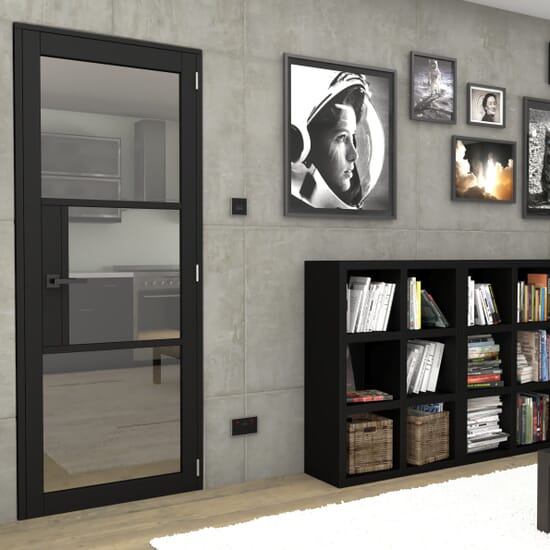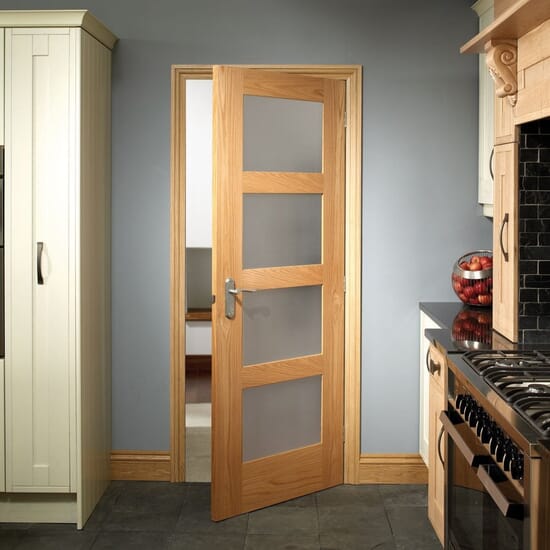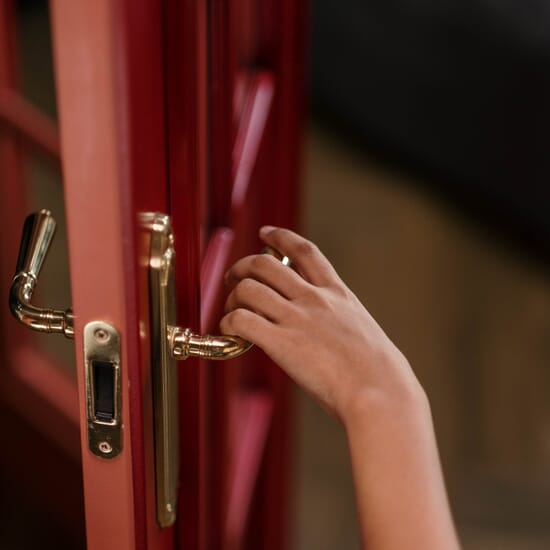- Mark up your new door. Hold up the door to the opening and ascertain which is the top, which is the hinge side and which the lock side. This may be obvious with a solid wood panelled door as the bottom rail is always deeper than the top and either side can act as hinge and lock sides. With a hollow core door, you will need to locate the lock block (a piece of solid wood within the door enabling you to screw the latch and handles into it). Manufacturers may have already stamped some of these markings on the door. Mark the top with a T, the hinge side with an H and the lock side with L or LB. To avoid ruining the paint, stick a bit of masking tape to the door and write the labels in pencil on top of that.
- Check the door against the frame (sometimes also called the lining or the casing) to find out if the frame is square, plumb and “in wind” (meaning it’s not twisted). If the frame isn’t perfect (and most aren’t so don’t worry) you can shape the door to fit as you go. If the door is too tall to hold up to the opening, saw an appropriate amount from the bottom so that you can hold it in place, but at this point, the gap at the bottom should be as small as possible, as you may need to take some from the top later on.
- Check the width of your opening. Measure carefully across in three places: top, middle and bottom, and write the measurements in the appropriate places on the door. Then check the door measurements in the same places.
- If necessary, reduce the width of the door to fit by planning equal amounts from each side of the door. This will maintain the door’s symmetry if it’s panelled, and will avoid cutting into the fibreboard if it’s hollow core. There should be a gap of no more than 2mm between the door and the frame when in place. If you need to remove more than 6mm from any edge, it will be more efficient to cut this first with a saw before planning the final amount. Don’t take the whole amount off in one go – you can’t stick it back on if you’ve removed too much. Keep trying it in the door frame to check the fit as you go. Saw and plane from the outside in to avoid splintering the wood. You may not need to adjust your doors at all if you’ve measured them correctly before purchasing but just in case we’ve included these instructions as well.
- Fit the top of the door. Hold the door up to touch the top of the frame to check if they are parallel. If they are, you need do no more. If not, you will need to shape the top to fit. Hold the door up in place with wedges at the bottom and measure the gap at the widest side. Remove the door and place on trestles, then measure down and mark this amount on the opposite side from the gap. For example, for a 7mm gap on the hinge side, measure and mark 7mm down on the lock side. Now mark a sloping line across the width of the door from this mark, gradually decreasing to nothing as you reach the opposite side. Finally, plane the door top so that it fits snugly with a 2mm gap between the door and the frame at the top.
- Check the leading edge. As an open door closes, the radius of the leading edge is increased, so you should plane this to create a very slight angle to the full length of the door. This means that the widths of the door on its leading face will be approximately 2mm less than the widths on the other face. This will prevent the door from catching as it closes, even though it may fit perfectly when completely closed.
- Fit the bottom edge. This is normally around 6mm but you can vary this depending on the floor covering. Hold the door in position in the frame with a 2mm gap at the top and keep in place with wedges under the door. Ensure that the door edges are parallel to the frame at both sides. Now measure and mark 6mm (or your chosen gap) up from the floor at both edges. Remove the door, place onto trestles and mark a line across the width of the door from one mark to the other. Now plane to the line.
- Check your hinges. A 75mm hinge with three screw holes is the normal type used for hanging internal doors. The flap (or leaf) with two portions wrapped around the pivot pin will be fitted to the door while the flap with three portions around the pivot pin will be screwed to the frame. Make sure you have distinguished between the two.
Place the door securely on its edge with the hinge side uppermost and measure down 150mm from the top, then draw a line at this point about 20mm long. Lay the top of the open hinge on this mark and mark the length of the hinge flap on the door edge, again 20mm long. Draw a straight line between the ends of these two marks. Now measure the exact thickness of one hinge flap (this is the amount the door needs to be recessed to receive the hinge flap accurately) and mark this on the door face between the top and bottom markings for the hinge length.
Repeat this procedure for the bottom hinge, but measure up 200mm from the bottom edge for your first line, placing the other 75mm above this (if this is the length of your hinge). Heavier doors may require a third hinge placed midway between the other two. - Cut the recesses. Hold the chisel vertically with the bevelled edge against the wood which is to be removed. Use the hammer to cut downwards along the marked lines to the required depth. Then use the chisel to carefully make further cuts downwards, working with the grain, to the correct depth across the whole recess area. Gently remove the unwanted wood then trim the recess until the hinge flaps fit snugly into place. The hinges are made to ensure that the 2mm gap between the door and the frame is maintained, so make sure that the flap is flush with the rest of the door – not sunk too low or sitting proud, otherwise this will interfere with the smooth opening and closing of the door once hung.
- Fit the hinges to the door. Hold them in place and mark the positions of the screw holes. Use a bradawl (also called a screw starter for obvious reasons) to aid accurate screw insertion and prevent the wood from splitting. For hardwood, you may find you need to drill a pilot hole first. Use 25mm screws to attach the hinge flaps to the door.
- Mark the hinge positions on the frame. Hold the door in place, using wedges at the bottom to keep at 2mm gap at the top and with the edges parallel to the frame on both sides. Now use the hinge positions on the door to mark the frame appropriately. Draw lines around 20mm long in the same way as you did on the door edge. To make sure that the thickness of the door fits correctly up to the door stop on the frame, first measure from the edge of the door (not the recessed edge) to the beginning of the hinge and add 2mm. Now use this measurement to mark from the door stop across the frame and draw the vertical lines between your two hinge markings at this point.
- Chisel the hinge recesses in the frame. Use the same method as for the door to chisel carefully. You can check the fit as you go.
- Hang the door. Hold the door in the open position and use wedges to raise it to the correct position. Now mark the positions for the screws. Use the bradawl to start a screw hole for the centre screw in each hinge and insert the screw. Check the door for fit at the top and sides and ensure that it can open and close smoothly. Only once you are sure of this should you fit the remaining screws.
And there you go. Your door should be all set and ready to use.
In Summary
Now that you know how to fit and adjust your internal doors, why not check out our full range of internal doors to find the right one for your home. If you have any questions, get in touch with our friendly customer service team who will be happy to help.







